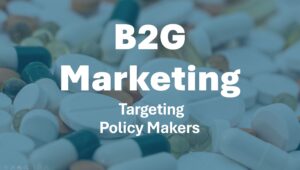by Sarah Colamarino
Have You Really Thought About Policy Makers?
Healthcare marketers can use the power of brands in B2G marketing for greater impact with policy makers. The way in which healthcare communicators interact with government and policy makers today is too often reactive and tactical. There is an opportunity to be more strategic in communicating with policy makers to better position healthcare for the future.

Taking a brand-forward approach to B2G marketing
As marketers and communicators in healthcare, we do know about a brand-forward approach. We understand that multi-stakeholder strategies should be based on a well-defined, clearly articulated brand. We focus on our product brands and increasingly our corporate brands in communications with customers and consumers to grow business. More recently, we are paying much-needed attention to our employer brands to attract and retain the best talent. But what about the government and policy makers whose perceptions of us have a major impact on our companies and industry’s success? When it comes to B2G communications, can we achieve more with better use of the principles of branding?
Current B2G communications approaches are tactical and PR-based
For healthcare and many other industries, government policy makers are as important as any other stakeholder group. And yet, the concept of building and demonstrating a brand in action is often missed. All many companies do is send out defensive messages in response to actions policy makers have taken that harm their interests. Healthcare companies have a huge opportunity to put forward a proactive point of view which convincingly demonstrates the benefits that we bring, not only to the social good, but to the economy and GDP.
An opportunity for proactive messages that go beyond defending costs
The healthcare policy maker dialogue often centers on cost. Companies focus their communications on fending off attacks and justifying the price of drugs.
A recent study by Goldman Sachs economists takes a much more productive perspective. It quantifies the economic gain from the growing usage of GLP-1 weight loss drugs. The economists argue that obesity drugs have the potential to boost economies even more than Taylor Swift. Obese people are less likely to work and less productive when they do. Obesity is linked to 30-50% of new diabetes cases every year. Medical costs for people with obesity are 30-40% higher than for people without obesity. The average number of days people miss work due to obesity is estimated at 3 days a year.
More than 40% of the US population is obese, with the number predicted to rise to over 50% by 2030. Obesity is higher among minorities and low-income populations. Over 50% of African Americans and 46% of Hispanics are already obese. If 60 million of the 137 million obese people in the US today took weight loss medications, and 90% of them benefited, the resulting expansion of the labor force and increase in productivity would translate into an over 1% boost in GDP.
Rather than defend costs, pharmaceutical companies can transform their B2G messaging to talk about how their weight loss medications create exponential economic benefits on a global scale. Led by Novo Nordisk, the maker of Ozempic and Wegovy, weight loss drugs have been responsible for the 1.8% growth in the Danish economy in 2023. The pharmaceutical industry accounted for all economic growth, according to the country’s statistics office. That is a powerful and strategic B2G story that has real impact.
Use your brand strategically for B2G marketing
All this should make us think deeply about what healthcare brands can stand for with policy makers. Think about it—do we really have good insights into this stakeholder group? Do we focus on pricing and cost when the real value is the impact on people’s lives and the potential to positively impact economies? Do we use our brand voice to advocate for underserved conditions and populations? Are we speaking to what policy makers really care about?
Replace defensive tactical communications with brand messaging
We should change how we address the B2G audience. We should be building trust and credibility – not advocating for our point of view. The precision marketing, which we now do, can deliver a very specific message to the right policy maker at the right time. But we can do better if we embark on an integrated brand-based strategy to engage with government policy makers. We should focus on content marketing which provides insights and offers educational content to help them do their jobs better. We should be doing consistent engagement on social media to demonstrate a brand’s intent to become part of a solution. If we undertake sponsorships of mutually important causes, or work with NGOs, healthcare brands can communicate what they really stand for – equitable access to healthcare based on cutting-edge innovation. Benefiting the world by making it healthier.
Seize the power of your brand in your B2G marketing
Challenge your own thinking. Do you have unique insights about how your brand can engage in meaningful ways with government stakeholders? Have you built a strategy to create an enduring brand based on societal and economic benefits? We should be using the power of our brands and communications to get everyone to understand that healthcare is a core driver of economic growth and prosperity.
Interested in learning more? Reach out and we can take you through our unique approach to evaluating and building the financial value of brands among policy makers as well as other stakeholders.